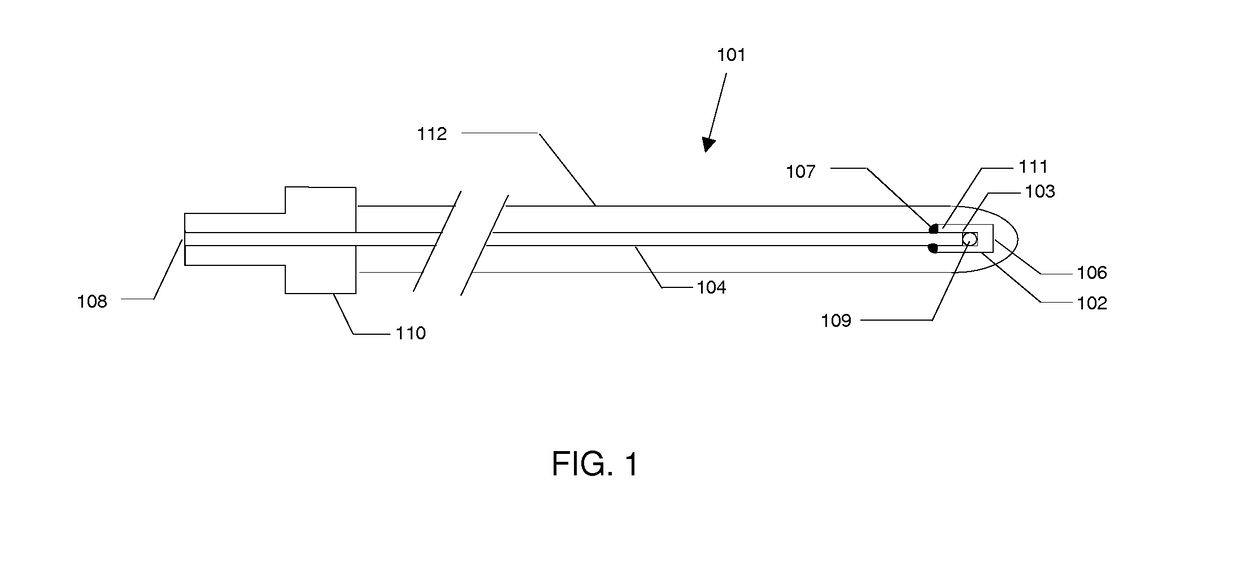Fiber optic temperature sensor utilizing a phosphor microsphere
a temperature sensor and fiber optic technology, applied in the field of fiber optic temperature sensors utilizing phosphor microspheres, can solve the problem of limited flexibility of probes, and achieve the effect of improving coupling efficiency and increasing the absorption of excitation ligh
- Summary
- Abstract
- Description
- Claims
- Application Information
AI Technical Summary
Benefits of technology
Problems solved by technology
Method used
Image
Examples
first embodiment
[0036]FIG. 1 illustrates the present invention, a flexible fiber optic thermal probe 101 utilizing a phosphor microsphere 109. The sensor end 103 of an optical fiber 104 is polished and held in contact with the phosphor microsphere 109 inside a ceramic tube 102 having a closed end 106 and an open end 111. Note, however, that the contact occurs at only a single point. Thus, for all intent and purposes, the phosphor microsphere 109 is surrounded by air, which has a much lower index of refraction. Such a construction endows the phosphor microsphere 109 with a built-in lens. The result is that the coupling of the excitation light into the phosphor microsphere 109, as well as of the fluorescence produced therein back into the fiber, are improved. The phosphor microsphere 109 should have a diameter substantially the same as that of the optical fiber 104. The inside diameter of the ceramic tube 102 is sized to be just large enough so as to allow the phosphor microsphere 109 and the optical...
second embodiment
[0037]FIG. 2 illustrates the current invention, a rigid fiber optic thermal probe 105 utilizing a phosphor microsphere 109. The phosphor microsphere 109 is placed in a close fitting closed-ended thin ceramic tube 116. Then an optical fiber 104 with sensor end 103 that is polished is inserted until it makes contact with the phosphor microsphere 109. The diameter of the optical fiber 104 is substantially the same as that of the phosphor microsphere 109. The optical fiber 104 is bonded to the thin ceramic tube 116 at its open end with adhesive 107. Next, the thin ceramic tube 116 is inserted into a close fitting thick ceramic tube 118 for protection, and bonded to the thick ceramic tube 118 with adhesive 107. Finally, the entire assembly is put into a fiber connector 110, and the connector end 108 of the optical fiber 104 is terminated therein.
[0038]The performance and cost of the thermal probe is determined by its desired range of operation. For example, the optical fiber 104 in the r...
PUM
| Property | Measurement | Unit |
|---|---|---|
| temperature | aaaaa | aaaaa |
| temperature | aaaaa | aaaaa |
| temperatures | aaaaa | aaaaa |
Abstract
Description
Claims
Application Information
 Login to View More
Login to View More - R&D
- Intellectual Property
- Life Sciences
- Materials
- Tech Scout
- Unparalleled Data Quality
- Higher Quality Content
- 60% Fewer Hallucinations
Browse by: Latest US Patents, China's latest patents, Technical Efficacy Thesaurus, Application Domain, Technology Topic, Popular Technical Reports.
© 2025 PatSnap. All rights reserved.Legal|Privacy policy|Modern Slavery Act Transparency Statement|Sitemap|About US| Contact US: help@patsnap.com



